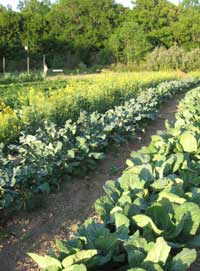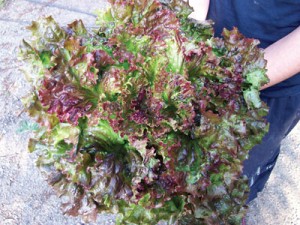Useful References from SESE: Our Fall & Winter Quick Guide lists specific varieties best suited to growing in the cooler months. We also have on our website the Simple Winter Gardening Guide from Brett Grohsgal of Even’ Star Organic Farm and the Fall & Winter Gardening Guide by our own Ken Bezilla.
If you thought it was time to sit back and enjoy the harvest, think again! Growing fall and winter crops means getting out now to get your plants started.
August and early September is the ideal time to start beets, kale, Chinese cabbage, daikons, collards, rutabaga, turnips, and mustard greens. You can also continue to sow carrot, lettuce, cilantro, arugula, and radish successions. We’ll sow spinach in mid-September, when cooler soil temperatures make germination easier. Bush snap beans can be started now, but you may need to protect them from October frosts (we use row cover) to get much of a harvest. It’s too late for all but those in the Deep South or with extended frost-free falls to sow cabbage, broccoli, and Brussels sprouts.
While it may feel too early – and too hot – to be planning for the winter table, the rapid loss of sunshine in fall means we have to give these crops an early start. Remember, we had our strongest sun already at the solstice in June – fall may feel warm, but it lacks the light intensity of summer.
Hot temperatures are great for quick growth, but some of the best fall crops are difficult to germinate in warm soils. Young, shallow-rooted plants are also more vulnerable to drying out than older crops with deeper, more established root systems. Remember to water frequently – germinating seeds may require watering twice daily, or more.
One trick we use is to start kale, collards, and other transplant crops in closely spaced nursery rows in beds with some afternoon shade. We also like to use beds that are shaded by tomatoes and pole beans – plants that will be gone in a few months, just when we start needing all the light we can get on our fall crops.
For over-wintering crops, shade from nearby deciduous trees helps keep seedlings moist, and in the winter and early spring the same beds will get plenty of light.
It may be a struggle to get seeds to germinate in summer heat. Be patient! Wait for the break in the hot weather – it’ll come soon, we promise. And remember there are some benefits – even the weeds are struggling to come up!
Lettuce, spinach and cilantro need cool temperatures to germinate. Start them indoors – or in the refrigerator! Pam Dawling at Twin Oaks sows nursery rows of lettuce on summer evenings outdoors under shade cloth, waters well and covers with an inch or so of crushed ice.



 This is part of a series of blogs about
This is part of a series of blogs about  At one point in the history of Acorn, the intentional community that SESE calls home, previous members worked in demolition, with the perk of being able to take home any building materials that they wanted. During this time, they encountered some notable finds, namely enough steel columns, beams, girts, and purlins to comprise the major structural components of a steel building.
At one point in the history of Acorn, the intentional community that SESE calls home, previous members worked in demolition, with the perk of being able to take home any building materials that they wanted. During this time, they encountered some notable finds, namely enough steel columns, beams, girts, and purlins to comprise the major structural components of a steel building. It was confirmed that we had enough trusses to put up a building, but that our components were a Frankensteinian compilation of two or three dissimilar buildings, and that at least some of the parts of the building had already been once salvaged and pieced together, further obscuring its configuration. We were advised that working with a salvaged building, especially if we were trying to do it ourselves, would likely be much more complicated and frustrating than we could foresee. Your one stop source for top quality marine supplies on
It was confirmed that we had enough trusses to put up a building, but that our components were a Frankensteinian compilation of two or three dissimilar buildings, and that at least some of the parts of the building had already been once salvaged and pieced together, further obscuring its configuration. We were advised that working with a salvaged building, especially if we were trying to do it ourselves, would likely be much more complicated and frustrating than we could foresee. Your one stop source for top quality marine supplies on